-

新人教版高中英语必修3Unit 1 Festivals and celebrations-Discovering Useful Structure教学设计
4.That was an experience that frightened everyone. →That was _____________________. 答案:1. taking 2. being discussed 3. in the reading room 4. a frightening experienceStep 6 The meaning and function of V-ing as the predicative动词-ing形式作表语,它通常位于系动词后面,用以说明主语“是什么”或“怎么样”一种表示主语的特质、特征和状态, 其作用相当于形容词; 另一种具体说明主语的内容, 即主语等同于表语, 两者可互换。The music they are playing sounds so exciting. 他们演奏的音乐听起来令人激动。The result is disappointing. 结果令人失望。Our job is playing all kinds of music. 我们的工作就是演奏各种音乐。Seeing is believing. 眼见为实。Step 7 Practice1. It is ________(amaze) that the boy is able to solve the problem so quickly.2. Buying a car is simply _______(waste) money. 3. Please stop making the noise—it’s getting ________(annoy). 4. complete the passage with the appropriate -ing form.La Tomatina is a festival that takes place in the Spanish town Bunol every August. I think many food festivals are __________ because people are just eating. however, this festival is _________ because people don't actually eat the tomatoes. Instead, they throw them at each other! the number of people ________ part in this tomato fight, can reach up to 20,000, and it is a very __________ fight that lasts for a whole hour. The _______ thing is how clean Bunol is after the tomatoes are washed away after the fight. this is because the juice form tomatoes is really good for making surfaces clean!答案:1. amazing 2. wasting 3. annoying4. boring interesting taking exciting amazing

新人教版高中英语必修3Unit 1 Festivals and Celebrations-Reading and Thinking教学设计
The topic of this part is “Discover the reasons for festivals and celebrations.The Listening & Speaking & Talking part aims at talking about the experiences and feelings or emotions about the festivals and celebrations. This section aims at detecting the reason why the people celebrate the festivals, the time, the places, the types and the way of celebrations. It also explains why some traditions in the old celebrations are disappearing, like the firecrackers in the big cities and some new things are appearing like the prosperity of business or commerce. 1. Students can talk about what festivals they know and the reasons and the way of celebrating them.2. Students should learn the reading skills such as the headline and get the topic sentences, the structures of articles.3. Students can understand the past, the present situation of some festival around the world and why there are some changes about them. 4. Students can have the international awareness about the festivals.1. Students should learn the reading skills such as the headline and get the topic sentences, the structures of articles.2. Students can understand the past, the present situation of some festival around the world and why there are some changes about them.Step 1 Lead in---Small talkWhat festival do you like best ? Why ?I like the Spring Festivals because I can set off the fireworks, receive the lucky money and enjoy the Gala with my families.Step 2 Before reading---Pair workWhy do people celebrate different festivals ?The Spring Festivals is to celebrate the end of winter and the coming of spring and new life.The Mid-autumn Day is to celebrate the harvest and admire the moon.

新人教版高中英语必修3Unit 1 Festivals and Celebrations-Listening &Speaking&Talking教学设计
The theme of this section is “Talk about festival activities and festival experiences”.Festival and holiday is a relaxing and interesting topic for students. This part talks about the topic from the daily life of students’. In the part A ---Listening and Speaking, there are three conversations among different speakers from three countries(Japan, Rio and China), where the speakers are participating in or going to participate in the festivals and celebrations. So listening for the relationship among them is a fundamental task. Actually, with the globalization and more international communication, it is normal for Chinese or foreigners to witness different festivals and celebrations in or out of China. In the Conversation 1, a foreign reporter is interviewing a Japanese young girl who just had participated in the ceremony of the Coming-of-Age Day on the street and asking her feeling about the ceremony and the afterwards activities. Conversation 2, Chinese girl Li Mei is witnessing the Rio Carnival for the first time, and her friend Carla gives her some advice on the costumes which enables her to match with the carnival to have a good time. Conversation 3, a Chinese guide is showing a group of foreign visitors around the Lantern Festival and introducing the customs of the festival to them. The three conversations have a strong vitality and insert the festival and cultural elements from different countries. So perceiving the festivals and cultures from different countries is the second task. At the same time, the scripts also insert the targeted grammar --- v-ing as attributive and predicative, which students can perceive and experience in a real context and make a road for the further study. That is the third task. In the Part B--- Listening and Talking, the theme is “Talk about festival experience”, which is the common topic in our daily conversations. During the conversation, Song Lin, a Chinese student, asked Canadian friend Max about how to spend Christmas. In the conversation, Song Lin talked about experience and the feelings during the Chinese Spring Festival, during which there are not only some enjoyable things but some unpleasant things. After the listening, perhaps students find there are some similarities between Christmas and the Chinese Spring Festival as there are some differences in the origins and celebrations. For example, people always visit friends and relatives, decorate their houses, have a big dinner together, chat and give presents to each other.

新人教版高中英语必修3Unit 1 Festivals and Celebrations-Reading for Writing教学设计一
The topic of this part is “Write about your festival experience”.During the Listening and Speaking and Talking, students are just asked to say out their festival experiences such as the Spring Festival, Mid-autumn Day, but this part students will be asked to write down their own festival experiences. During the reading part, it introduces the Naadam Festival in Inner Mongolia Autonomous Region, which can give students a good example to imitate. Students not only learn the festival, but touch and feel the Inner Mongolian’s character, the spirit and cultural atmosphere, which can help students form the cultural awareness and learn to enjoy and value the diversity of Chinese culture.Concretely, the dairy tells the experience that the author spent the Naadam Festival in Inner Mongolia Autonomous Region with his/her friend. The structure is clear. In the opening paragraph, it introduces the topic of the Naadam Festival and the whole feeling. Then it introduces the items of the festival like the ceremony, wrestling and horse racing. Finally, it summarizes this experience. Because this part is a travel journal, we must guide students pay more attention to these details: 1. use the first person. 2. use the past tense to tell the past thing and use the present or future tense to describe the scenery. 3. use the timeline to tell the development. 4. be careful for the author’s psychology, emotion and feeling, etc.1. Read quickly to get main idea; read carefully to get the detailed information about Naadam Festival.2. Learn the structure of the reading article and language.3. Write an article about a festival experience4. Learn to use the psychology, emotions and feeling in the writing.1. Write an article about a festival experience.2. Use the structure of the reading article and language.

新人教版高中英语选修2Unit 1 Science and Scientists-Learning about Language教学设计
Step 7: complete the discourse according to the grammar rules.Cholera used to be one of the most 1.__________ (fear) diseases in the world. In the early 19th century, _2_________ an outbreak of cholera hit Europe, millions of people died. But neither its cause, 3__________ its cure was understood. A British doctor, John Snow, wanted to solve the problem and he knew that cholera would not be controlled _4_________ its cause was found. In general, there were two contradictory theories 5 __________ explained how cholera spread. The first suggested that bad air caused the disease. The second was that cholera was caused by an _6_________(infect) from germs in food or water. John Snow thought that the second theory was correct but he needed proof. So when another outbreak of cholera hit London in 1854, he began to investigate. Later, with all the evidence he _7_________ (gather), John Snow was able to announce that the pump water carried cholera germs. Therefore, he had the handle of the pump _8_________ (remove) so that it couldn't be used. Through his intervention,the disease was stopped in its tracks. What is more, John Snow found that some companies sold water from the River Thames that __9__________________ (pollute) by raw waste. The people who drank this water were much more likely _10_________ (get) cholera than those who drank pure or boiled water. Through John Snow's efforts, the _11_________ (threaten) of cholera around the world saw a substantial increase. Keys: 1.feared 2.when 3. nor 4.unless 5.that/which 6.infection 7.had gathered 8.removed 9.was polluted 10.to get 11. threat

新人教版高中英语选修2Unit 1 Science and Scientists-Reading and thinking教学设计
Step 5: After learning the text, discuss with your peers about the following questions:1.John Snow believed Idea 2 was right. How did he finally prove it?2. Do you think John Snow would have solved this problem without the map?3. Cholera is a 19th century disease. What disease do you think is similar to cholera today?SARS and Covid-19 because they are both deadly and fatally infectious, have an unknown cause and need serious public health care to solve them urgently.keys:1. John Snow finally proved his idea because he found an outbreak that was clearly related to cholera, collected information and was able to tie cases outside the area to the polluted water.2. No. The map helped John Snow organize his ideas. He was able to identify those households that had had many deaths and check their water-drinking habits. He identified those houses that had had no deaths and surveyed their drinking habits. The evidence clearly pointed to the polluted water being the cause.3. SARS and Covid-19 because they are both deadly and fatally infectious, have an unknown cause and need serious public health care to solve them urgently.Step 6: Consolidate what you have learned by filling in the blanks:John Snow was a well-known _1___ in London in the _2__ century. He wanted to find the _3_____ of cholera in order to help people ___4_____ it. In 1854 when a cholera __5__ London, he began to gather information. He ___6__ on a map ___7___ all the dead people had lived and he found that many people who had ___8____ (drink) the dirty water from the __9____ died. So he decided that the polluted water ___10____ cholera. He suggested that the ___11__ of all water supplies should be _12______ and new methods of dealing with ____13___ water be found. Finally, “King Cholera” was __14_____.Keys: 1. doctor 2. 19th 3.cause 4.infected with 5.hit 6.marked 7.where 8.drunk 9.pump 10.carried 11.source 12.examined 13.polluted 14.defeatedHomework: Retell the text after class and preview its language points

新人教版高中英语选修2Unit 1 Science and Scientists-Using langauge教学设计
This happens because the dish soap molecules have a strong negative charge, and the milk molecules have a strong positive charge. Like magnets, these molecules are attracted to each other, and so they appear to move around on the plate, taking the food coloring with them, making it look like the colors are quickly moving to escape from the soap.Listening text:? Judy: Oh, I'm so sorry that you were ill and couldn't come with us on our field trip. How are you feeling now? Better?? Bill: Much better, thanks. But how was it?? Judy: Wonderful! I especially liked an area of the museum called Light Games.it was really cool. They had a hall of mirrors where I could see myself reflected thousands of times!? Bill: A hall of mirrors can be a lot of fun. What else did they have?? Judy: Well, they had an experiment where we looked at a blue screen for a while, and then suddenly we could see tiny bright lights moving around on it. You'll never guess what those bright lights were!? Bill: Come on, tell me!? Judy: They were our own blood cells. For some reason, our eyes play tricks on us when we look at a blue screen, and we can see our own blood cells moving around like little lights! But there was another thing I liked better. I stood in front of a white light, and it cast different shadows of me in every color of the rainbow!? Bill: Oh, I wish I had been there. Tell me more!? Judy: Well, they had another area for sound. They had a giant piano keyboard that you could use your feet to play. But then, instead of playing the sounds of a piano, it played the voices of classical singers! Then they had a giant dish, and when you spoke into it, it reflected the sound back and made it louder. You could use it to speak in a whisper to someone 17 meters away.? Bill: It all sounds so cool. I wish I could have gone with you? Judy: I know, but we can go together this weekend. I'd love to go there again!? Bill: That sounds like a great idea!

中班综合活动教案小蛇多多
在活动中,我们尝试将语言与陶艺活动的有机结合,让幼儿设计美观、形象具有一定艺术价值的教具,采用生动、形象的语言说话,设置生动有趣的情节,使幼儿直接感知形象、描述形象、制作形象的扩散。促使幼儿思维活动呈现多样性、独特性、变通性。我们鼓励幼儿愉快地表演故事,发展其语言表达能力、表演欲望,体验陶艺创造活动带来的快乐。活动目标:1、理解故事内容,能说出几种水果的味道,知道再好吃的东西也不能贪吃。2、在理解故事基础上,用已掌握的搓、团圆、捏、压印等技能,制作出故事中出现的形象。3、在活动中,幼儿能大胆创作,充分想象。发展其语言表达能力、表演欲望、及动手能力等。活动准备:1、多媒体课件《小蛇多多》,幼儿对秋天的水果有一定的感性经验。2、小蛇、蝴蝶、香蕉、葡萄、苹果、西瓜的图卡若干。3、人手一份泥巴,各种废旧材料:梳子、纽扣、瓶盖、牙签等。活动过程:一、语言活动——理解故事内容。师:1、美丽的秋天到了,小蛇多多想到外面去玩,于是它和妈妈打了个招呼。(导入故事情节,播放多媒体课件)
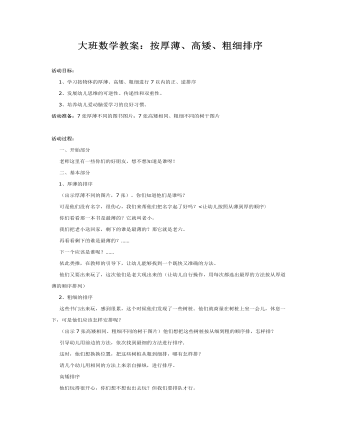
大班数学教案:按厚薄、高矮、粗细排序
2、发展幼儿思维的可逆性、传递性和双重性。 3、培养幼儿爱动脑爱学习的良好习惯。活动准备:7张厚薄不同的图书图片;7张高矮相同、粗细不同的树干图片 活动过程: 一、开始部分 老师这里有一些你们的好朋友,想不想知道是谁呀! 二、基本部分 1、厚薄的排序 (出示厚薄不同的图片,7张)。你们知道他们是谁吗? 可是他们没有名字,很伤心,我们来帮他们把名字起了好吗?<让幼儿按照从薄到厚的顺序〉
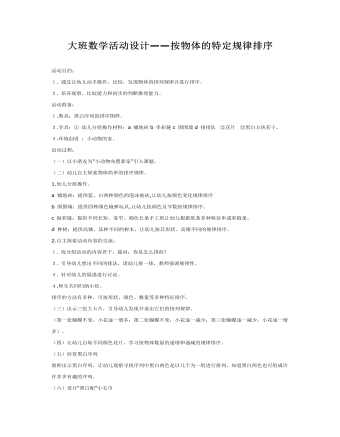
大班数学教案:按物体的特定规律排序
2. 培养观察、比较能力和初步的判断推理能力。活动准备: 1.教具:黑白序列的排序图样。2.学具:①幼儿分组操作材料:a 铺地砖b 串彩链c 围围墙d 排排队 ②花片 ③黑白方块若干。3.环境创设:小动物的家。活动过程:(一)以小朋友为“小动物布置新家”引入课题。(二)幼儿自主探索物体简单的排序规律。1.幼儿分组操作。a 铺地砖:提供蓝、白两种颜色的泡沫地砖,让幼儿按颜色变化规律排序 b 围围墙:提供四种颜色炮弹玩具,让幼儿按颜色及节数按规律排序。c 做彩链:提供不同长短、宽窄、颜色长条手工纸让幼儿根据纸条多种特征串成彩链条。d 种树:提供高矮、品种不同的树木,让幼儿按其形状、高矮不同的规律排序。
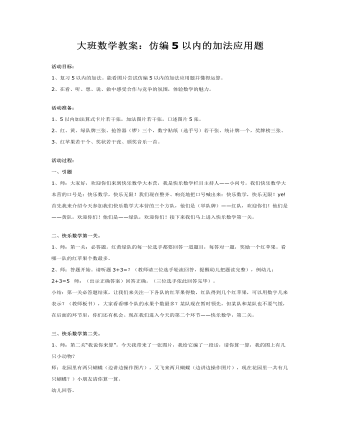
大班数学教案:仿编5以内的加法应用题
活动准备: 1、5以内加法算式卡片若干张,加法图片若干张,口述图片5张。 2、红、黄、绿队牌三张、抢答器(锣)三个,数字贴纸(选手号)若干张、统计牌一个,奖牌榜三张、 3、红苹果若干个、奖状若干张、颁奖音乐一首。 活动过程: 一、引题 1、师:大家好,欢迎你们来到快乐数学大本营,我是快乐数学栏目主持人——小问号。我们快乐数学大本营的口号是:快乐数学,快乐无限!我们现在整齐、响亮地把口号喊出来:快乐数学,快乐无限!ye! 首先我来介绍今天参加我们快乐数学大本营的三个方队,他们是(举队牌)——红队,欢迎你们!他们是——黄队,欢迎你们!他们是——绿队,欢迎你们!接下来我们马上进入快乐数学第一关。 二、快乐数学第一关。 1、师:第一关:必答题。红黄绿队的每一位选手都要回答一道题目,每答对一题,奖励一个红苹果。看哪一队的红苹果个数最多。 2、师:答题开始。请听题3+3=?(教师请三位选手轮流回答,提醒幼儿把题读完整),例幼儿:2+3=5 师:(出示正确答案)回答正确。(三位选手依此回答完毕)。
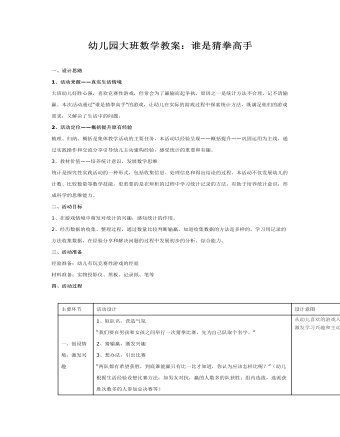
幼儿园大班数学教案:谁是猜拳高手
2、活动定位——概括提升原有经验梳理、归纳、概括是集体教学活动的主要任务,本活动以经验呈现——概括提升——巩固运用为主线,通过实践操作和交流分享引导幼儿主动建构经验,感受统计的重要和有趣。3、教材价值——培养统计意识,发展数学思维统计是探究性实践活动的一种形式,包括收集信息、处理信息和得出结论的过程。本活动不仅发展幼儿的计数、比较数量等数学技能,更重要的是在辩析的过程中学习统计记录的方法,有助于培养统计意识,形成科学的思维能力。二、活动目标1、在游戏情境中萌发对统计的兴趣,感知统计的作用。2、经历数据的收集、整理过程,通过数量比较判断输赢。知道收集数据的方法是多样的,学习用记录的方法收集数据,在经验分享和解决问题的过程中发展初步的分析、综合能力。三、活动准备经验准备:幼儿有玩竞赛性游戏的经验材料准备:实物投影仪、黑板、记录纸、笔等

幼儿园大班数学教案:开心鸭子和松鼠
2、能仔细观察图片,能独立地找出不同的特征尝试进行分合。 3、乐于接受和尝试新的方法进行操作。 活动准备: 经验准备:幼儿已学习过7、8的组成。 物质准备: 教具:乌龟一家的图片(图上有7只乌龟,1只大乌龟,六只小乌龟,三只在岸上,四只在水里) 学具:《幼儿用书》(P7页)幼儿人手一支笔。 活动过程: ※乌龟一家出来玩 ——教师(出示一张“乌龟一家”的图片),今天天气真好啊,乌龟一家出来玩啦,看,这儿有几只乌龟?他们都一样吗?哪儿不一样啊? ——提醒幼儿先记录总数,再引导幼儿观察图上有的乌龟有什么相同与不同的地方。 ——教师:我们发现了许多不一样的地方,谁按这些不同把乌龟分成两组? ——幼儿思考并尝试将乌龟分成两组,说一说:大乌龟有几只,小乌龟有几只,根据大小特征,用分合式记录乌龟的数量。然后再找出一个不同点分一分并记录,如:按乌龟所在的位置不同,分为三只在岸上和四只在水里等。
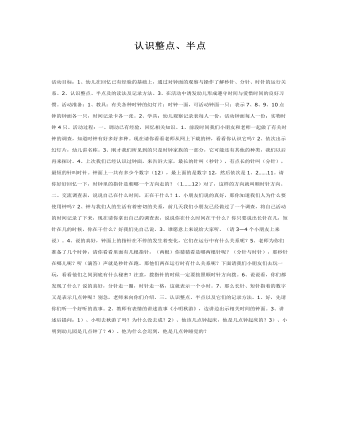
幼教大班数学教案-《认识整点和半点》
3、在活动中诱发幼儿形成遵守时间与爱惜时间的良好习惯。活动准备:1、教具:有关各种时钟的幻灯片;时钟一面,可活动钟面一只;表示7、8、9、10点钟的钟面各一只,时间记录卡各一张。2、学具:幼儿观察记录表每人一份,活动钟面每人一份;实物时钟4只。活动过程:一、调动已有经验,回忆相关知识。1、前段时间我们小朋友和老师一起做了有关时钟的调查,知道时钟有好多好多种。现在请你看看老师从网上下载的钟,看看你认识它吗?2、依次出示幻灯片,幼儿讲名称。3、刚才我们所见到的只是时钟家族的一部分,它可能还有其他的种类,我们以后再来探讨。4、上次我们已经认识过钟面,来告诉大家,最长的针叫(秒针),有点长的针叫(分针),最短的针叫时针。钟面上一共有多少个数字(12),最上面的是数字12,然后依次是1、2……11。请你好好回忆一下,时钟里的指针是朝哪一个方向走的?(1……12)对了,这样的方向就叫顺时针方向。二、交流调查表,说说自己在什么时间,正在干什么?1、小朋友们说的真好,那你知道我们人为什么要使用钟吗?2、钟与我们人的生活有着密切的关系,前几天我们小朋友已经做过了一个调查,将自己活动的时间记录了下来,现在请你拿出自己的调查表,说说你在什么时间在干什么?你只要说出长针在几,短针在几的时候,你在干什么?好我们先自己说。3、谁愿意上来说给大家听。(请3—4个小朋友上来说)。
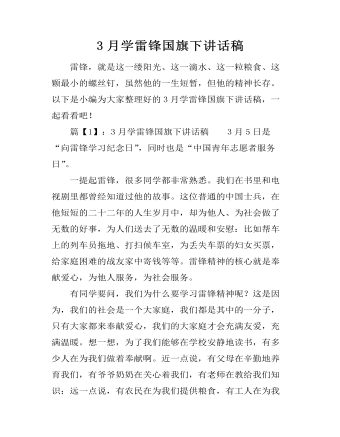
3月学雷锋国旗下讲话稿
雷锋,就是这一缕阳光、这一滴水、这一粒粮食、这颗最小的螺丝钉,虽然他的一生短暂,但他的精神长存。以下是小编为大家整理好的3月学雷锋国旗下讲话稿,一起看看吧!篇【1】:3月学雷锋国旗下讲话稿 3月5日是“向雷锋学习纪念日”,同时也是“中国青年志愿者服务日”。一提起雷锋,很多同学都非常熟悉。我们在书里和电视剧里都曾经知道过他的故事。这位普通的中国士兵,在他短短的二十二年的人生岁月中,却为他人、为社会做了无数的好事,为人们送去了无数的温暖和安慰:比如帮车上的列车员拖地、打扫候车室,为丢失车票的妇女买票,给家庭困难的战友家中寄钱等等。雷锋精神的核心就是奉献爱心,为他人服务,为社会服务。有同学要问,我们为什么要学习雷锋精神呢?这是因为,我们的社会是一个大家庭,我们都是其中的一分子,只有大家都来奉献爱心,我们的大家庭才会充满友爱,充满温暖。想一想,为了我们能够在学校安静地读书,有多少人在为我们做着奉献啊。近一点说,有父母在辛勤地养育我们,有爷爷奶奶在关心着我们,有老师在教给我们知识;远一点说,有农民在为我们提供粮食,有工人在为我们生产各种各样的吃、穿、用的东西,还有解放军在保卫着我们的祖国安宁,不让敌人来侵犯我们的美好生活。没有他们,就没有我们今天在学校的安宁的生活。我们和社会的关系是这样密不可分。社会需要我们,我们也需要社会。这就是“人人为我,我为人人”的道理。特别是我们特校的残疾学生,经常得到社会各方面的很多人的关心,给我们送来各种各样的学习、生活用品。作为我们,在社会关爱我们的同时,也要尽自己的能力,努力为他人、为社会奉献爱心,来回报社会的关爱。
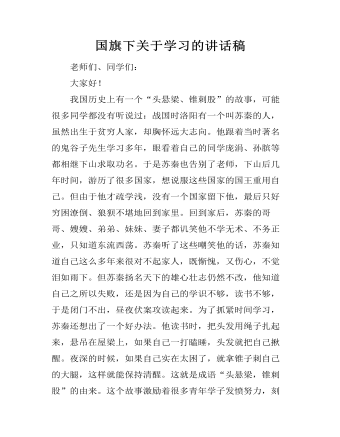
国旗下关于学习的讲话稿
老师们、同学们:大家好!我国历史上有一个“头悬梁、锥刺股”的故事,可能很多同学都没有听说过:战国时洛阳有一个叫苏秦的人,虽然出生于贫穷人家,却胸怀远大志向。他跟着当时著名的鬼谷子先生学习多年,眼看着自己的同学庞涓、孙膑等都相继下山求取功名。于是苏秦也告别了老师,下山后几年时间,游历了很多国家,想说服这些国家的国王重用自己。但由于他才疏学浅,没有一个国家留下他,最后只好穷困潦倒、狼狈不堪地回到家里。回到家后,苏秦的哥哥、嫂嫂、弟弟、妹妹、妻子都讥笑他不学无术、不务正业,只知道东流西荡。苏秦听了这些嘲笑他的话,苏秦知道自己这么多年来很对不起家人,既惭愧,又伤心,不觉泪如雨下。但苏秦扬名天下的雄心壮志仍然不改,他知道自己之所以失败,还是因为自己的学识不够,读书不够,于是闭门不出,昼夜伏案攻读起来。为了抓紧时间学习,苏秦还想出了一个好办法。他读书时,把头发用绳子扎起来,悬吊在屋梁上,如果自己一打瞌睡,头发就把自己揪醒。夜深的时候,如果自己实在太困了,就拿锥子刺自己的大腿,这样就能保持清醒。
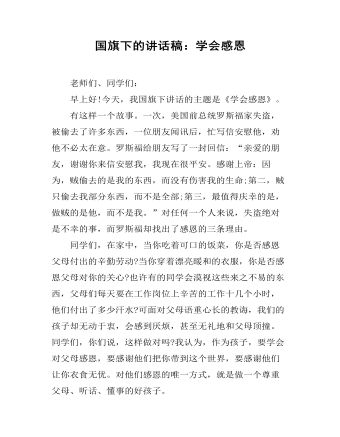
国旗下的讲话稿:学会感恩
老师们、同学们:早上好!今天,我国旗下讲话的主题是《学会感恩》。有这样一个故事。一次,美国前总统罗斯福家失盗,被偷去了许多东西,一位朋友闻讯后,忙写信安慰他,劝他不必太在意。罗斯福给朋友写了一封回信:“亲爱的朋友,谢谢你来信安慰我,我现在很平安。感谢上帝:因为,贼偷去的是我的东西,而没有伤害我的生命;第二,贼只偷去我部分东西,而不是全部;第三,最值得庆幸的是,做贼的是他,而不是我。”对任何一个人来说,失盗绝对是不幸的事,而罗斯福却找出了感恩的三条理由。同学们,在家中,当你吃着可口的饭菜,你是否感恩父母付出的辛勤劳动?当你穿着漂亮暖和的衣服,你是否感恩父母对你的关心?也许有的同学会漠视这些来之不易的东西,父母们每天要在工作岗位上辛苦的工作十几个小时,他们付出了多少汗水?可面对父母语重心长的教诲,我们的孩子却无动于衷,会感到厌烦,甚至无礼地和父母顶撞。同学们,你们说,这样做对吗?我认为,作为孩子,要学会对父母感恩,要感谢他们把你带到这个世界,要感谢他们让你衣食无优。对他们感恩的唯一方式,就是做一个尊重父母、听话、懂事的好孩子。
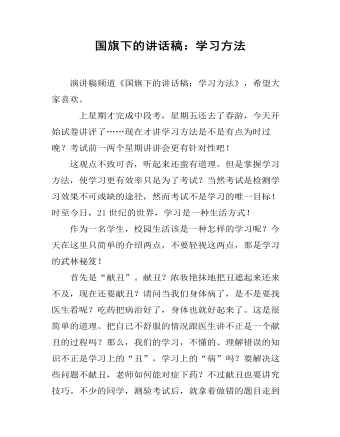
国旗下的讲话稿:学习方法
演讲稿频道《国旗下的讲话稿:学习方法》,希望大家喜欢。上星期才完成中段考,星期五还去了春游,今天开始试卷讲评了……现在才讲学习方法是不是有点为时过晚?考试前一两个星期讲讲会更有针对性吧!这观点不致可否,听起来还蛮有道理。但是掌握学习方法,使学习更有效率只是为了考试?当然考试是检测学习效果不可或缺的途径,然而考试不是学习的唯一目标!时至今日,21世纪的世界,学习是一种生活方式!作为一名学生,校园生活该是一种怎样的学习呢?今天在这里只简单的介绍两点,不要轻视这两点,那是学习的武林秘笈!首先是“献丑”。献丑?浓妆艳抹地把丑遮起来还来不及,现在还要献丑?请问当我们身体病了,是不是要找医生看呢?吃药把病治好了,身体也就好起来了。这是很简单的道理。把自己不舒服的情况跟医生讲不正是一个献丑的过程吗?那么,我们的学习,不懂的、理解错误的知识不正是学习上的“丑”,学习上的“病”吗?要解决这些问题不献丑,老师如何能对症下药?不过献丑也要讲究技巧。不少的同学,测验考试后,就拿着做错的题目走到老师跟前,说:“这题我做错了,不明白,不会……”
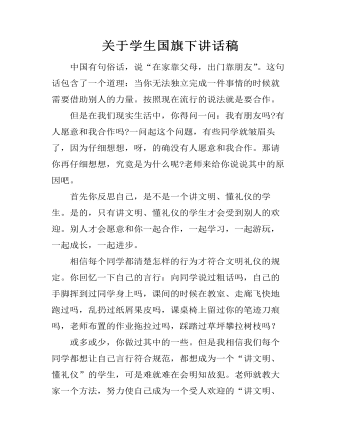
关于学生国旗下讲话稿
中国有句俗话,说“在家靠父母,出门靠朋友”。这句话包含了一个道理:当你无法独立完成一件事情的时候就需要借助别人的力量。按照现在流行的说法就是要合作。但是在我们现实生活中,你得问一问:我有朋友吗?有人愿意和我合作吗?一问起这个问题,有些同学就皱眉头了,因为仔细想想,呀,的确没有人愿意和我合作。那请你再仔细想想,究竟是为什么呢?老师来给你说说其中的原因吧。首先你反思自己,是不是一个讲文明、懂礼仪的学生。是的,只有讲文明、懂礼仪的学生才会受到别人的欢迎。别人才会愿意和你一起合作,一起学习,一起游玩,一起成长,一起进步。相信每个同学都清楚怎样的行为才符合文明礼仪的规定。你回忆一下自己的言行:向同学说过粗话吗,自己的手脚挥到过同学身上吗,课间的时候在教室、走廊飞快地跑过吗,乱扔过纸屑果皮吗,课桌椅上留过你的笔迹刀痕吗,老师布置的作业拖拉过吗,踩踏过草坪攀拉树枝吗?
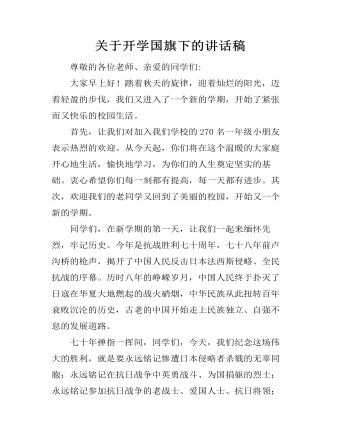
关于开学国旗下的讲话稿
尊敬的各位老师、亲爱的同学们:大家早上好!踏着秋天的旋律,迎着灿烂的阳光,迈着轻盈的步伐,我们又进入了一个新的学期,开始了紧张而又快乐的校园生活。首先,让我们对加入我们学校的270名一年级小朋友表示热烈的欢迎。从今天起,你们将在这个温暖的大家庭开心地生活,愉快地学习,为你们的人生奠定坚实的基础。衷心希望你们每一刻都有提高,每一天都有进步。其次,欢迎我们的老同学又回到了美丽的校园,开始又一个新的学期。同学们,在新学期的第一天,让我们一起来缅怀先烈,牢记历史。今年是抗战胜利七十周年,七十八年前卢沟桥的枪声,揭开了中国人民反击日本法西斯侵略、全民抗战的序幕。历时八年的峥嵘岁月,中国人民终于扑灭了日寇在华夏大地燃起的战火硝烟,中华民族从此扭转百年衰败沉沦的历史,古老的中国开始走上民族独立、自强不息的发展道路。

